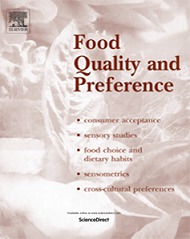Do individual differences in visual attention to CATA questions affect sensory product characterization? A case study with plain crackers
Dublin Core
Título
Tema
Abstract
A consumer study was carried out in which 113 participants were asked to evaluate six plain crackers and to answer a check-all-that-apply question composed of 20 sensory terms, which was presented on a computer screen. While consumers completed the CATA tasks their eye movements were recorded using a remote eye-tracker. Considerable heterogeneity among participants existed with regard to the number
of fixations made when completing the CATA questions. Three groups of consumers who differed in their degree of visual processing (more thorough to less thorough) were identified. These groups also differed in their responses to the CATA question. Consumers who performed the most thorough visual processing of the CATA question, used, on average, a significantly larger number of CATA terms to describe the products
than consumers in the other two groups. Meanwhile, consumers who engaged in the least detailed visual processing showed lesser discriminative ability. However, sensory spaces from the three consumer groups were highly similar, suggesting that consumers identified the same similarities and differences
among samples despite differing in the degree of visual attention directed to the CATA question
Fuente
Editor
Fecha
Derechos
Información sobre Derechos de Autor
(Por favor lea este aviso antes de abrir los documentos u objetos)
La legislación uruguaya protege el derecho de autor sobre toda creación literaria, científica o artística, tanto en lo que tiene que ver con sus derechos morales, como en lo referente a los derechos patrimoniales con sujeción a lo establecido por el derecho común y las siguientes leyes
(LEY 9.739 DE 17 DE DICIEMBRE DE 1937 SOBRE PROPIEDAD LITERARIA Y ARTISTICA CON LAS MODIFICACIONES INTRODUCIDAS POR LA LEY DE DERECHO DE AUTOR Y DERECHOS CONEXOS No. 17.616 DE 10 DE ENERO DE 2003, LEY 17.805 DE 26 DE AGOSTO DE 2004, LEY 18.046 DE 24 DE OCTUBRE DE 2006 LEY 18.046 DE 24 DE OCTUBRE DE 2006)
ADVERTENCIA - La consulta de este documento queda condicionada a la aceptación de las siguientes condiciones de uso: Este documento es únicamente para usos privados enmarcados en actividades de investigación y docencia. No se autoriza su reproducción con fines de lucro. Esta reserva de derechos afecta tanto los datos del documento como a sus contenidos. En la utilización o cita de partes debe indicarse el nombre de la persona autora.
Formato
Idioma
Tipo
Identificador
Document Item Type Metadata
Original Format
- Fecha de agregación
- April 21, 2016
- Colección
- Bibliografía Nacional Química
- Tipo de Elemento
- Document
- Etiquetas
- CATA, Comportamiento del consumidor, Evaluación sensorial
- Citación
- Antúnez, Lucía, “Do individual differences in visual attention to CATA questions affect sensory product characterization? A case study with plain crackers,” RIQUIM - Repositorio Institucional de la Facultad de Química - UdelaR, accessed July 23, 2024, https://riquim.fq.edu.uy/items/show/3884.
- Archivos

